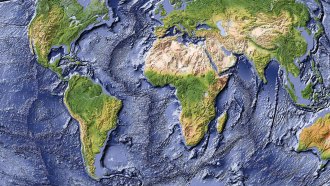Earth
-
 Climate
Climate50 years ago, scientists warned of the ‘neglected dangers’ of heat islands
In 1973, scientists knew temperatures in cities were higher than in rural areas. Now, some cities are attempting to cool down with engineering.
-
 Life
Life10 billion snow crabs have disappeared off the Alaskan coast. Here’s why
In the eastern Bering Sea, the snow crab population plummeted after a marine heat wave in 2018. The crabs may have starved, a new study finds.
By Jude Coleman -
 Climate
ClimateRóisín Commane sleuths out greenhouse gas leaks to fight climate change
From New York City to the Arctic, atmospheric chemist Róisín Commane tries to account for the greenhouse gases in the air.
By Jennifer Lu -
 Animals
AnimalsA global report finds amphibians are still in peril. But it’s not all bad news
A survey of about 8,000 amphibian species provides the latest update on extinction risk trends stretching back to 1980.
By Anna Gibbs -
 Animals
AnimalsIn noisy environs, pied tamarins are using smell more often to communicate
Groups of the primate, native to Brazil, complement vocalizations with scent-marking behavior to alert other tamarins to dangers in their urban home.
-
 Paleontology
PaleontologyNew computer analysis hints volcanism killed the dinosaurs, not an asteroid
Scientists take a creative approach to investigating what caused the mass extinction 66 million years ago, but the debate is far from settled.
-
 Climate
Climate‘Our Fragile Moment’ finds modern lessons in Earth’s history of climate
Michael Mann’s latest book, Our Fragile Moment, looks through Earth’s history to understand the current climate crisis.
-
 Earth
EarthTo form pink diamonds, build and destroy a supercontinent
The Argyle deposit in Australia formed about 1.3 billion years ago, a study shows, along a rift zone that sundered the supercontinent Nuna.
By Nikk Ogasa -
 Physics
PhysicsA laser gyroscope measured tiny variations in the lengths of days on Earth
An underground gyroscope known as ‘G’ uses laser beams traveling in opposite directions to precisely measure Earth’s rotation.
-
 Oceans
Oceans‘The Deepest Map’ explores the thrills — and dangers — of charting the ocean
A new book follows the race to map the seafloor, documenting how it’s done, why and what a clear view of the deep sea could mean for Earth’s future.
-
 Climate
ClimateWhat’s driving an increasing number of hurricanes to rapidly intensify?
Hurricane Lee is just the latest storm to explode in power in only hours. The phenomenon is linked to a warming world.
-
 Earth
EarthWhen discussing flora and fauna, don’t forget ‘funga’
Conservation efforts often overlook fungi. That can change by using “mycologically inclusive language,” researchers say.
By Jude Coleman